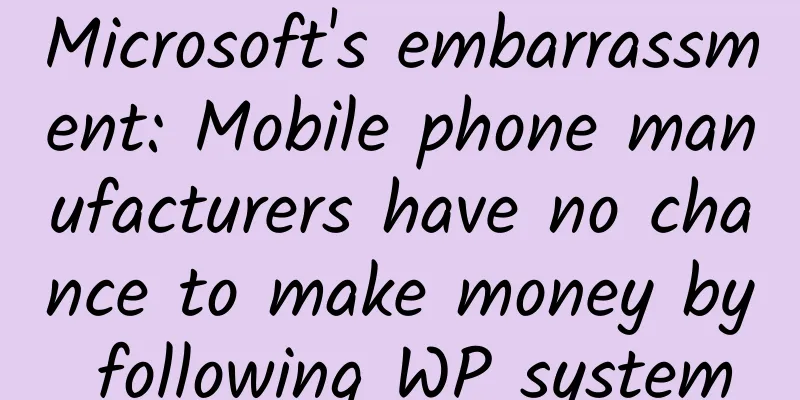Microsoft's embarrassment: Mobile phone manufacturers have no chance to make money by following WP system

|
Joe Kelly, head of international media affairs at Huawei, recently revealed in an interview with the Seattle Times that the company has never made a profit on the two devices running the WP system, and claimed that "no manufacturer has made any money from WP devices." This statement immediately caused an uproar in the industry. After all, as one of the top four manufacturers in the global and Chinese smartphone markets, Huawei's attitude and views on Microsoft Windows Phone (hereinafter referred to as WP) cannot be underestimated. The impact on Microsoft and its partners cannot be underestimated. Perhaps from now on, Microsoft will really embark on a lonely and defeated path in the smartphone market. So why did Microsoft end up in this embarrassing situation today? Or as Huawei said, it can't make money by following Microsoft to adopt its WP? The industry knows that whether a product can make money is closely related to many factors such as the product's brand effect, market positioning, marketing strategy, etc. In this sense, when Microsoft reached a strategic cooperation with Nokia, it had already laid the groundwork for its own WP embarrassment today. Although Microsoft and Nokia joined forces to promote their own WP ecosystem with the help of Nokia's hardware platform, from the subsequent marketing strategy, Lumia and Nokia brands have frequently appeared in various Microsoft marketing events, which made Microsoft partners, who were already worried about the strategic cooperation between Microsoft and Nokia, feel that it would be more difficult to make their own WP system phones stand out. Even if they wanted to, it would increase marketing costs. At the same time, given that these Microsoft partners are almost all manufacturers in the Android camp, and the well-known fact is that the competition in the Android camp is fierce, and few manufacturers can make considerable profits except Samsung. In this case, who would invest energy in WP phones (in fact, there is no extra energy). This negative impact reached its peak after Microsoft announced the acquisition of Nokia's mobile phone business and gave up the Nokia brand. Before the acquisition of Nokia's mobile phone business, Microsoft and Nokia had a close cooperation, and Nokia was still an OEM manufacturer of Microsoft. No matter how much Microsoft allocated resources to Nokia, the nature of the OEM manufacturer did not change substantially. But with the acquisition of Nokia's mobile phone business by Microsoft, especially after the acquisition, Microsoft gave up the Nokia brand and promoted the Lumia brand. Microsoft undoubtedly put itself in opposition to its partners. Some people may say that in order to attract partners, didn’t Microsoft waive the licensing fee for WP before? Isn’t this from the perspective of partners to reduce the burden on partners? Of course! However, this free strategy came too late. If it was a few years earlier, at least when Google Android, which is also free, did not have such a big leading advantage as it does today, this move might have made some sense. Although Microsoft waived the licensing fee for WP, compared with Android, Microsoft WP has one thing that is ignored or short-boarded. Android is not only free, but also an open source system. This provides OEM partners with the space to customize the system according to their own and user needs and the ability to compete in a differentiated manner in the market, which is something that the closed WP cannot provide. This also leaves its OEM manufacturers with no choice but to compete on price based on homogeneity, thereby further compressing profit margins. Speaking of price, we naturally bring up the issue of Microsoft WP's market positioning. If Microsoft still had the courage and initiative to compete with Apple and Google in the high-end smartphone market during the strategic cooperation phase with Nokia (although mid- and low-end Lumia phones had already occupied the majority of WP phone shipments at that time, at least it also launched Lumia 1020 and Lumia 1520 high-end flagship products), then with the smartphones released and featured after Microsoft acquired Nokia's mobile phone business, Microsoft has already made the low-end market its only strategy for its Lumia brand and phones, or Microsoft smartphones. Why do you think so? According to Amazon.com's previous statistics, three of the top five best-selling non-contract phones on the site are Windows Phones. They are Lumia 520, Lumia 521 and Lumia 635, ranking first, third and fourth respectively. The recently released Lumia 535 (the first phone that Microsoft officially abandoned the Nokia brand and used the Lumia logo alone) is positioned at the low end and is considered by the industry to be a symbol of Microsoft's strategic shift in smartphones. In addition, when Google released Android One for the low-end market, there were reports that Microsoft planned to launch a project called "First", with mobile phones priced below US$40 (approximately RMB 246) to compete with Google for the next billion users (users in emerging markets who care about price). Perhaps Microsoft's change in WP mobile phone strategy is nothing to itself, which is rich and powerful, and has its own value, but it is not a good sign for OEM partners. Not to mention that OEM manufacturers have to launch WP phones with similar or lower prices to compete with Microsoft's already low-priced Lumia phones, thereby reducing their profit margins. Judging from the strategies of mainstream mobile phone manufacturers in the current Android camp, they are changing from pursuing volume to pursuing revenue and profit (for example, Samsung, Huawei, ZTE, etc. are all significantly reducing their product lines), and Microsoft's strategy is obviously contrary to the strategies of these manufacturers. In this case, why should OEM manufacturers invest in Microsoft WP, invisibly lengthen their product lines and increase their own costs that will never be recovered? In summary, we believe that the changes in Microsoft's series of strategies in the smartphone market are the main reason why OEMs believe that following its WP system is not profitable. And considering that Microsoft CEO Nadella recently explained that Microsoft's research and development focus is mainly to open up the channel between Windows desktop system and Windows Phone when addressing the weak performance of the WP market, Microsoft's WP strategy will not change in the short term by relying on the strategy of transitioning and radiating the Windows development community to the WP platform. At the same time, the search data on the Google Trends website shows that users' search interest in the low-end Lumia 535 has continued to increase, and its sales in the Indian market, where the Nokia brand previously had a strong influence, have proven that Microsoft's brand transition from Nokia to Lumia has been successful, and it also seems to have strengthened Microsoft's confidence in its lonesome. As a winner of Toutiao's Qingyun Plan and Baijiahao's Bai+ Plan, the 2019 Baidu Digital Author of the Year, the Baijiahao's Most Popular Author in the Technology Field, the 2019 Sogou Technology and Culture Author, and the 2021 Baijiahao Quarterly Influential Creator, he has won many awards, including the 2013 Sohu Best Industry Media Person, the 2015 China New Media Entrepreneurship Competition Beijing Third Place, the 2015 Guangmang Experience Award, the 2015 China New Media Entrepreneurship Competition Finals Third Place, and the 2018 Baidu Dynamic Annual Powerful Celebrity. |
<<: LeTV's Peng Gang: Good smart hardware products should be done in moderation
>>: 99% of startups fail: Is decentralization the cure?
Recommend
Digging the root | Is hoarding a habit? Be careful, you may have this disease. Let's see if you have these symptoms
gossip Many people are reluctant to throw away th...
User Recall Practice: SMS Traffic Generation
The uninstall volume of most apps is increasing, ...
High-level system design and low-level system design in software development
The software development cycle goes through many ...
Low cost, high exposure, advertising optimization model!
How to optimize the effectiveness of advertising,...
Shengunju Practical Home Feng Shui Course 24 full video + notes Baidu cloud download
Baidu network disk location: n-30-Shen Gun Bureau...
Sir Zhang's "TikTok Account Traffic Growth Course" says goodbye to Neptune traffic and makes your traffic more accurate
Training course video content introduction: This ...
The acquitted leopard cat, is it a leopard or a cat?
A cat-sized ocelot appeared in the local news. Th...
2021 Nobel Prize in Physiology or Medicine: Scientific explanation of the body's sense of heat, cold and touch
Written by | Fanpu At 11:30 a.m. local time on Oc...
What happened to James' buzzer-beater? How did James make the buzzer beater?
What happened to James' buzzer-beater? How di...
A woman was hospitalized after eating raw pickles. Be careful when making your own raw pickles! It can cause diarrhea at the mildest and poisoning at the worst.
Recently, there was a trending search #Woman lear...
South Korea's Ministry of Land, Infrastructure and Transport: By the end of October 2022, the number of new energy vehicle registrations in South Korea had reached 1.515 million, a year-on-year increase of 38.3%
According to foreign media reports, in the wave o...
Anyone can make a phone? Is the threshold for the mobile phone industry low?
The most popular industry now is the mobile phone...
A guide to Xiaohongshu advertising strategies!
Strictly speaking, although Xiaohongshu is very p...
How can products be promoted effectively?
Many people write brilliant copy and make beautif...









